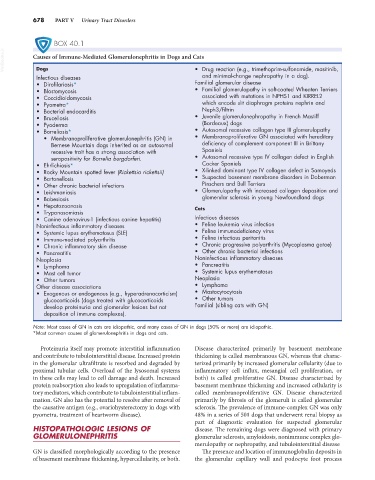Page 706 - Small Animal Internal Medicine, 6th Edition
P. 706
678 PART V Urinary Tract Disorders
BOX 40.1
VetBooks.ir Causes of Immune-Mediated Glomerulonephritis in Dogs and Cats
Dogs
• Drug reaction (e.g., trimethoprim-sulfonamide, masitinib,
Infectious diseases and minimal-change nephropathy in a dog).
• Dirofilariasis* Familial glomerular disease
• Blastomycosis • Familial glomerulopathy in soft-coated Wheaten Terriers
• Coccidioidomycosis associated with mutations in NPHS1 and KIRREL2
• Pyometra* which encode slit diaphragm proteins nephrin and
• Bacterial endocarditis Neph3/filtrin
• Brucellosis • Juvenile glomerulonephropathy in French Mastiff
• Pyoderma (Bordeaux) dogs
• Borreliosis* • Autosomal recessive collagen type III glomerulopathy
• Membranoproliferative glomerulonephritis (GN) in • Membranoproliferative GN associated with hereditary
Bernese Mountain dogs inherited as an autosomal deficiency of complement component III in Brittany
recessive trait has a strong association with Spaniels
seropositivity for Borrelia burgdorferi. • Autosomal recessive type IV collagen defect in English
• Ehrlichiosis* Cocker Spaniels
• Rocky Mountain spotted fever (Rickettsia rickettsii) • X-linked dominant type IV collagen defect in Samoyeds
• Bartonellosis • Suspected basement membrane disorders in Doberman
• Other chronic bacterial infections Pinschers and Bull Terriers
• Leishmaniasis • Glomerulopathy with increased collagen deposition and
• Babesiosis glomerular sclerosis in young Newfoundland dogs
• Hepatozoonosis Cats
• Trypanosomiasis
• Canine adenovirus-1 (infectious canine hepatitis) Infectious diseases
Noninfectious inflammatory diseases • Feline leukemia virus infection
• Systemic lupus erythematosus (SLE) • Feline immunodeficiency virus
• Immune-mediated polyarthritis • Feline infectious peritonitis
• Chronic inflammatory skin disease • Chronic progressive polyarthritis (Mycoplasma gatae)
• Pancreatitis • Other chronic bacterial infections
Neoplasia Noninfectious inflammatory diseases
• Lymphoma • Pancreatitis
• Mast cell tumor • Systemic lupus erythematosus
• Other tumors Neoplasia
Other disease associations • Lymphoma
• Exogenous or endogenous (e.g., hyperadrenocorticism) • Mastocytocytosis
glucocorticoids (dogs treated with glucocorticoids • Other tumors
develop proteinuria and glomerular lesions but not Familial (sibling cats with GN)
deposition of immune complexes).
Note: Most cases of GN in cats are idiopathic, and many cases of GN in dogs (50% or more) are idiopathic.
*Most common causes of glomerulonephritis in dogs and cats.
Proteinuria itself may promote interstitial inflammation Disease characterized primarily by basement membrane
and contribute to tubulointerstitial disease. Increased protein thickening is called membranous GN, whereas that charac-
in the glomerular ultrafiltrate is resorbed and degraded by terized primarily by increased glomerular cellularity (due to
proximal tubular cells. Overload of the lysosomal systems inflammatory cell influx, mesangial cell proliferation, or
in these cells may lead to cell damage and death. Increased both) is called proliferative GN. Disease characterized by
protein reabsorption also leads to upregulation of inflamma- basement membrane thickening and increased cellularity is
tory mediators, which contribute to tubulointerstitial inflam- called membranoproliferative GN. Disease characterized
mation. GN also has the potential to resolve after removal of primarily by fibrosis of the glomeruli is called glomerular
the causative antigen (e.g., ovariohysterectomy in dogs with sclerosis. The prevalence of immune-complex GN was only
pyometra, treatment of heartworm disease). 48% in a series of 501 dogs that underwent renal biopsy as
part of diagnostic evaluation for suspected glomerular
HISTOPATHOLOGIC LESIONS OF disease. The remaining dogs were diagnosed with primary
GLOMERULONEPHRITIS glomerular sclerosis, amyloidosis, nonimmune complex glo-
merulopathy or nephropathy, and tubulointerstitial disease
GN is classified morphologically according to the presence The presence and location of immunoglobulin deposits in
of basement membrane thickening, hypercellularity, or both. the glomerular capillary wall and podocyte foot process

